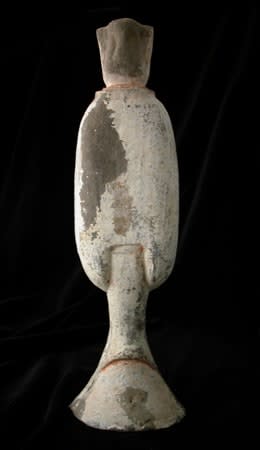Western Han Terracotta Sculpture of an Attendant, 206 BCE - 9 CE
Terracotta
6 x 18.5
H.024
Further images
The overextension of the labor force during the Qin Dynasty would result in a popular uprising against the empire. In 206 B.C., Liu Bang, a Qin official, led an army...
The overextension of the labor force during the Qin Dynasty would result in a popular uprising against the empire. In 206 B.C., Liu Bang, a Qin official, led an army composed of peasants and some lower nobility to victory and established his own Dynasty in place, the Han. However, unlike the Qin, the Han would unify China and rule virtually uncontested for over four hundred years. It is during this time that much of what is now considered to be Chinese culture was first actualized. The bureaucracy started under the Qin was now firmly established. The vast lands of China were now under the firm grip of a central authority. Confucianism became the state ideology although the worship of Taoist deity remained widespread, both among the peasants and the aristocracy. Ancient histories and texts were analyzed and rewritten to be more objective while new legendary myths and cultural epics were transcribed.
The Han era can also be characterized as one of the greatest artistic outpourings in Chinese history, easily on par with the glories of their Western contemporaries, Greece and Rome. Wealth pouring into China from trade along the Silk Road initiated a period of unprecedented luxury. Stunning bronze vessels were created, decorated with elegant inlaid gold and silver motifs. Jade carvings reached a new level of technical brilliance. But perhaps the artistic revival of the Han Dynasty is nowhere better represented than in their sculptures and vessels that were interred with deceased nobles. Called mingqi, literally meaning “spirit articles,” these works depicted a vast array of subject, from warriors and horses to ovens and livestock, which were buried alongside the dead for use in the next world, reflecting the Chinese belief that the afterlife was an extension of our earthy existence. Thus, quite logically, the things we require to sustain and nurture our bodies in this life would be just as necessary in our next life.
The tall slender figure is shown with hands hidden within the full sleeves of long robes, which are tightly gathered around the legs, before flaring widely to the sides. The various layered robes are visible at the neck and chest, molded in V-shaped necklines painted in red, white, and then a faint black border on the outermost robe. Two small holes appear in the portion that encapsules the hidden hands, perhaps to hoist an unattached object such as a staff or candle holder, or to link the figurine as if in a procession. The facial features are delicately painted over white slip, the elongated eye area in black pigment and mouth in red, while the nose is slightly molded in the middle and raised high above the ears. Han Dynasty tomb figures are noted for their naturalistic style and gracful, slender portrayals of human figures. They are not created as works of art; they were made to answer the needs of a particular belief about life after death and the spiritual world. The sculptor strove to capture the life and vitality of the subject rather than create a meticulous portrait, as their work was commissioned by the ruling classes to accompany the body and soul of the deceased into the realm of the spritual world.
The Han era can also be characterized as one of the greatest artistic outpourings in Chinese history, easily on par with the glories of their Western contemporaries, Greece and Rome. Wealth pouring into China from trade along the Silk Road initiated a period of unprecedented luxury. Stunning bronze vessels were created, decorated with elegant inlaid gold and silver motifs. Jade carvings reached a new level of technical brilliance. But perhaps the artistic revival of the Han Dynasty is nowhere better represented than in their sculptures and vessels that were interred with deceased nobles. Called mingqi, literally meaning “spirit articles,” these works depicted a vast array of subject, from warriors and horses to ovens and livestock, which were buried alongside the dead for use in the next world, reflecting the Chinese belief that the afterlife was an extension of our earthy existence. Thus, quite logically, the things we require to sustain and nurture our bodies in this life would be just as necessary in our next life.
The tall slender figure is shown with hands hidden within the full sleeves of long robes, which are tightly gathered around the legs, before flaring widely to the sides. The various layered robes are visible at the neck and chest, molded in V-shaped necklines painted in red, white, and then a faint black border on the outermost robe. Two small holes appear in the portion that encapsules the hidden hands, perhaps to hoist an unattached object such as a staff or candle holder, or to link the figurine as if in a procession. The facial features are delicately painted over white slip, the elongated eye area in black pigment and mouth in red, while the nose is slightly molded in the middle and raised high above the ears. Han Dynasty tomb figures are noted for their naturalistic style and gracful, slender portrayals of human figures. They are not created as works of art; they were made to answer the needs of a particular belief about life after death and the spiritual world. The sculptor strove to capture the life and vitality of the subject rather than create a meticulous portrait, as their work was commissioned by the ruling classes to accompany the body and soul of the deceased into the realm of the spritual world.







